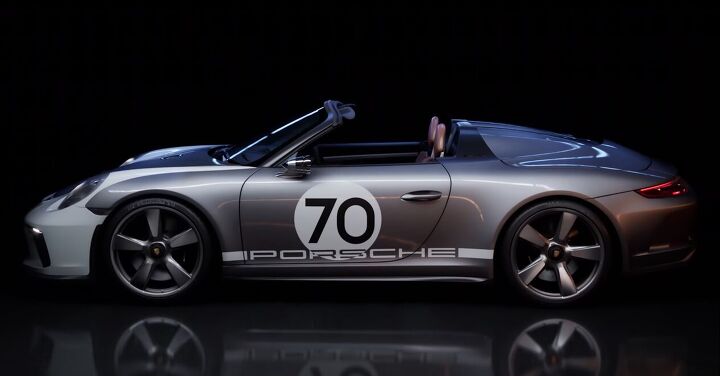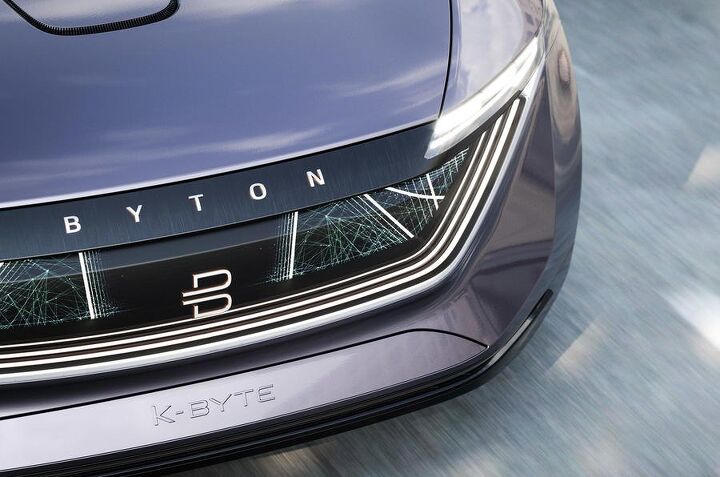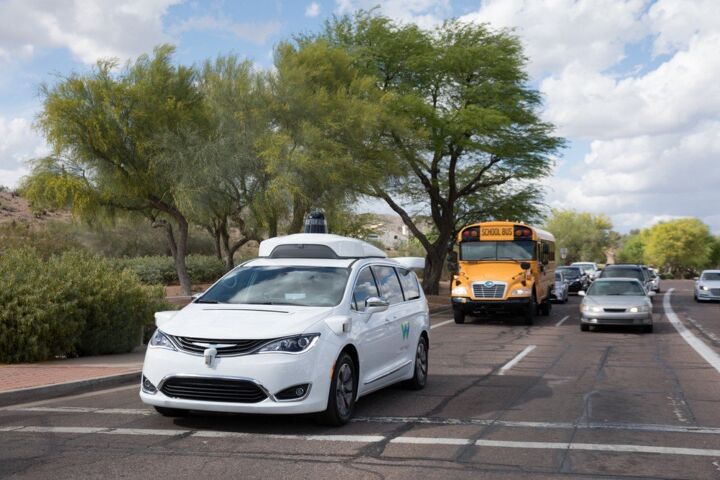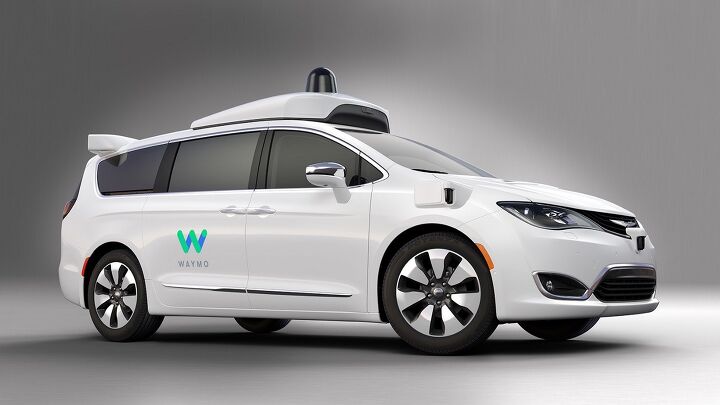#AutomotiveTechnology
Like Manual Transmissions, Handbrakes Are Also Hurtling Towards Extinction
We’ve long bemoaned the death of the manual transmission. But with few practical advantages other than being more enjoyable to a limited subset of the population, it’s quickly (and understandably) slipping into obscurity. It’s not alone. Based on research conducted by online automotive marketplace CarGurus, the good ol’ handbrake is also rapidly losing relevance as automakers shift their focus to electronic parking brakes.
Isolating its research to the United Kingdom, CarGurus claims just 37 percent of new cars leave the factory with a traditional, mechanical brake lever. And those that still have them are typically bargain-focused nameplates like Suzuki and Dacia. Considering neither of those brands sell any models here, the number is likely even lower in the United States.
Nearly Better Than the Real Thing: Porsche Taps Video Game Tech to Break New Ground in Automotive Design
Porsche has grown rather chummy with the video game community of late. In 2017, the automaker used North America’s largest gaming expo as a platform for the debut of the 911 GT2 RS. You can attribute that to a relatively recent marketing push that resulted in its vehicles appearing in interactive media after a long-standing absence. Porsche, for whatever reason, spent years being exceptionally choosy about which developers can license its vehicles for their games. This usually results in blockbuster titles using “RUF” as a placeholder or simply abandoning Porsche vehicles entirely.
The last five or six years have been different, however. Automakers want to broaden their marketing approach and get away from the big industry trade shows. For Porsche, that means video games, and the relationship is only getting stronger.
This week, Porsche Epic Games and the graphical processing wizards at NVIDIA gathered to showcase what they claim is a major breakthrough in computer design rendering. While we can’t say with any authority that this will forever change automotive design, what they’ve managed to accomplish certainly looks impressive.
What's the Chinese Electric Car Startup Survival Rate? One Percent, An Investor Predicts
China has bit of a gambling problem when it comes to electric car manufacturers, though it should probably be referred to as a “gambling solution.”
The country dumps vast sums of money into hundreds of EV startups, effectively hedging its bets by placing chips on absolutely everyone. With $15 billion already invested, the nation intends to put another $47 billion toward the cause — plus whatever funding investment firms decide to contribute. While the strategy has definitely stimulated the economy, created jobs, and supersized the industry, there’s growing concern that creating a battle royale between startups could blow up in China’s face.
Even if it doesn’t, there’ll still be a bunch of automakers eating each other until only a handful remain. Previous estimates had that number riding around 5 percent of the whole. But NIO Capital, the Chinese investment firm that’s already invested a gratuitous amount of funds into advanced automotive tech, claims the actual number will be far lower — probably around 1 percent.
Talking Cars: Amazon Lets Loose Alexa Software Kit for Infotainment Systems
You’re likely familiar with Amazon’s cloud-based virtual home assistant Alexa. She’s the little voice that lives inside the Echo, a device which allows consumers to manage their calendar, set alarms, create a shopping list, adjust the thermostat, play music, and a multitude of other functions all via voice command. However, if you’re anything like me, you probably just ask Alexa to tell you bad jokes and read the morning news.
Alexa has found her way into cars lately — most notably those produced by Hyundai, thanks to a partnership with Amazon. But it looks like she’s about to find her way into a whole bunch more. On Thursday, Amazon announced the Alexa Auto Software Development Kit, which provides developers a way to easily integrate all of Alexa’s functions into automotive infotainment systems.
Automakers Working Feverishly to Make Car Keys Disappear
Keys have evolved quite a bit over the last century. Most cars don’t require that you use a traditional key anymore, and proximity sensors take away the need to even lock and unlock a vehicle’s doors. While some of us appreciate the satisfying sensation of pressing a button or turning a key, it’s grown unnecessary. But some automakers want to take things a step further and abandon keys altogether.
We’ve heard BMW mention this before. Back in 2017, the brand’s head of sales said the automaker was actively reassessing the practical value of car keys now that keyless entry is the norm. “Honestly, how many people really need [keys],” Robertson said. “They never take it out of their pocket, so why do I need to carry it around?”
Now, the Car Connectivity Consortium (CCC), which includes BMW, General Motors, Hyundai, Volkswagen, Audi, Lincoln, Apple, LG, Samsung, Panasonic, and more, has published the Digital Key Release 1.0 specification. The aim is to establish a standardized solution for the industry that enables drivers to download a digital key onto their smart devices and use it on every vehicle they own.
Tesla and NTSB Squabble Over Crash; America Tries to Figure Out How to Market 'Mobility' Responsibly
The National Transportation Safety Board, which is currently investigating last month’s fatal crash involving Tesla’s Autopilot system, has removed the electric automaker from the case after it improperly disclosed details of the investigation.
Since nothing can ever be simple, Tesla Motors claims it left the investigation voluntarily. It also accused the NTSB of violating its own rules and placing an emphasis on getting headlines, rather than promoting safety and allowing the brand to provide information to the public. Tesla said it plans to make an official complaint to Congress on the matter.
The fallout came after the automaker disclosed what the NTSB considered to be investigative information before it was vetted and confirmed by the investigative team. On March 30th, Tesla issued a release stating the driver had received several visual and one audible hands-on warning before the accident. It also outlined items it believed attributed to the brutality of the crash and appeared to attribute blame to the vehicle’s operator. The NTSB claims any release of incomplete information runs the risk of promoting speculation and incorrect assumptions about the probable cause of a crash, doing a “disservice to the investigative process and the traveling public.”
Driving Aids Allow Motorists to Tune Out, NTSB Wants Automakers to Fix It
Driving aids are touted as next-level safety tech, but they’re also a bit of a double-edged sword. While accident avoidance technology can apply the brakes before you’ve even thought of it, mitigate your following distance, and keep your car in the appropriate lane, it also lulls you into a false sense of security.
Numerous members of the our staff have experienced this first hand, including yours truly. The incident usually plays out a few minutes after testing adaptive cruise control or lane assist. Things are progressing smoothly, then someone moves into your lane and the car goes into crisis mode — causing you to ruin your undergarments. You don’t even have to be caught off guard for it to be a jarring experience, and it’s not difficult to imagine an inexperienced, inattentive, or easily panicked driver making the situation much worse.
Lane keeping also has its foibles. Confusing road markings or snowy road conditions can really throw it for a loop. But the problem is its entire existence serves to allow motorists to take a more passive role while driving. So what happens when it fails to function properly? In ideal circumstances, you endure a moderate scare before taking more direct command of your vehicle. But, in a worst case scenario, you just went off road or collided with an object at highway speeds.
Safety Group to Senate: Clue in to the 'Baseless and Exaggerated Predictions' Swirling Around Autonomous Vehicles
Last year, the National Highway Traffic Safety Administration embraced autonomous technology by redefining how it categorized cars. Spurred by automakers and tech companies, the government has opened its eyes to this new technology and seen it as a way to potentially save lives by reducing the number of roadway accidents caused by human error.
Congress has been confronted with numerous pieces of legislation on the matter, too — prospective laws that would allow automakers to put hundreds of thousands of autonomous vehicles on the street, without the need to adhere to existing safety regulations. Many have called the move necessary if the United States hopes to be the first country to produce a truly self-driving car and start saving some lives.
It sounds almost too good to be true, and some claim it actually is. A group of public interest organizations is attempting to sound the bullshit alarm, claiming automakers are misleading government officials in the hopes of developing and profiting from unproven technology.
Waymo to Purchase 'Thousands' of Chrysler Pacificas for Self-driving Duty
Waymo, the self-driving division of Google’s parent company Alphabet, just announced it has reached a deal to purchase a buttload of Pacifica minivans from Fiat Chrysler Automobiles. Alright, to be fair, it didn’t actually use the term “buttload.” It said Chrysler would provide “thousands” of units, which will ultimately be outfitted for autonomous driving.
Unfortunately, neither company seems willing to disclose an official count. Waymo currently has around 600 self-driving Pacificas in its fleet, so even an extra thousand vehicles would equate to a multi-million dollar deal and the exponential growth of its autonomous development program.
“With the world’s first fleet of fully self-driving vehicles on the road, we’ve moved from research and development to operations and deployment,” Waymo CEO John Krafcik said in an official statement. “These additional vehicles will help us scale.”
Atlanta Becomes Next American City to Host Waymo's Autonomous Test Fleet
Waymo, the self-driving unit of Google parent Alphabet, is testing the crap out of its ever-growing fleet of autonomous Chrysler Pacificas. While we know the company has already mapped dozens of North American towns, the majority of its testing takes place around Austin, Detroit, Palo Alto, San Francisco, Seattle, and especially Phoenix.
However, today the company tweeted out that it will add Atlanta, Georgia, to that list. Presently, Arizona is the only region where Waymo routinely operates vehicles without a human behind the wheel. But that’s liable to change as the firm gets more testing under its belt. Atlantans may be leaning out of car windows to snap photos of driverless vans soon enough.
No Thanks: Nissan Wants to Input Your Brainwaves on Tomorrow's Cars
Certain automotive technologies are getting borderline out of hand. But nothing stops the march toward progress. Keen to show off its developmental might, Nissan plans to unveil something called “brain-to-vehicle” (B2V) technology at next week’s Consumer Electronics Show.
While the system borders on the fantastical, Nissan claims it can interpret signals from a driver’s brain to help a semi-autonomous vehicle understand how to best respond.
Automakers Need to Improve Voice Command Systems ASAP
Amazon’s Echo has already invaded homes across North America, but it’s now beginning to creep into vehicle infotainment systems. My parents have one and both are quite fond of its ability to answer basic queries through intuitive voice commands. Though my mother refers to the system as my father’s “new wife,” it prefers to be addressed as Alexa when being issued instructions. If you need another point of reference, it’s reminiscent of Apple’s Siri, the computer from Star Trek, and any other automated technology using a female voice as the primary interface.
However, as handy as these systems are, they sometimes make mistakes. Alexa is great at giving me the weather but, when you give her more complex requests, she’ll sometimes get confused. That’s not a big problem when you are able to whip out your phone and go online, but it can be real annoying when driving. Early voice command interfaces in automobiles were infuriating — it was often easier to give up and input whatever information you were trying to shout at Ford Sync, BMW iDrive, or whatever decade-old system you happened to be using.
Thankfully, voice recognition is far better now than it was in 2008. But with so many concerns about automotive safety cropping up, it’s a little surprising that nobody has yet perfected an interface that effectively allows motorists to keep their hands where they belong — on the wheel.
GM Adds Digital Marketplace to Its Vehicles for Onboard Purchasing
General Motors has announced it is the first automaker with its very own in-car commerce platform. We aren’t the least bit surprised.
In fact, we’ve been waiting for GM to announce something like this ever since it expressed an interest in using OnStar to deliver “personalized marketing offers” a little over a year ago. Since then, the manufacturer has also indicated plans to create an app store accessible from a vehicle’s infotainment system, as well as use driver data acquisition as a possible revenue source.
While GM isn’t the only company taking this path, it’s arguably the one that’s gotten the furthest. Our takeaway is that the services being rendered and developed are extremely clever ways for an automaker to rake in money, but will not be universally popular. This early example of GM’s changing business model ought to make the company a bundle while aggravating a certain percentage of consumers.
Jaguar Land Rover Enters the Autonomous Race, Test Vehicles on Public Roads
Jaguar Land Rover has taken its first steps into the scariest part of autonomous development — real world testing.
As most automakers are already deep into R&D work on self-driving cars, luxury manufacturers like JLR cannot afford to be late to the party. In today’s world, premium automobiles are less about ride quality or cabin space and more about having the latest and greatest tech. A big, comfortable car isn’t hard to come by — they used to build them all the time. They also aren’t particularly expensive, especially if you shop on the used market.
However, a 2005 Lincoln Town Car in the driveway doesn’t scream “prestige” to the neighbors. But an autonomous Range Rover that parks itself in the garage while you get the mail is something else entirely. If you had a vehicle like that, the guy across the street would have difficulty even holding your now-powerful gaze — shamed by his own car’s clear inferiority. Imagine what kind of price you might pay to have that kind of mastery over another person. Now you can see why this technology is so important to JLR.
Ford's Hackett: 'Dumb Cars' Will Be a Thing of the Past
“Ford’s future is not about giving up the car,” Jim Hackett, Ford chief executive officer, exclaimed at the Michigan CEO Summit in Detroit on Thursday. But he promises there will be “no dumb cars in the future.”
The executive was not assuring attendees that Ford has no plans to revive the Mustang II, rather, he was talking about the brand’s continued efforts to press onward into the development of electric, connected, and self-driving automobiles on a global scale. With Wall Street still fixated on tech, it would be surprising to hear any automotive executive say otherwise.






























Recent Comments